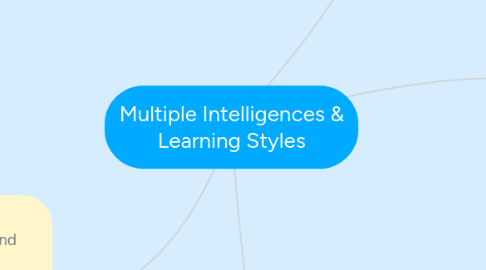
1. How teachers can impact a students MI
1.1. 1. Developing new intelligences in students by broadening the curriculum to allow them to become the best they can be
1.2. 2. Teaching the intelligences by making all content accessible to students in each way that they feel most comfortable with-based on their personal multiple intelligences. If we ignore this, then we will be ignoring the many different forms of intelligence and only focusing on one form if we choose to teach in one form only.
1.3. 3. Celebrating uniqueness and diversity among students. If we break the different 'levels' of intelligence up into these eight different categories
2. What are learning style inventories and why should teachers use them in classrooms?
2.1. A learning style inventory is simply a way for the instructor to access information about their students and how they learn. This can be useful because it allows the teacher to create a lesson with a variety of ways to match student's different intelligences.
2.2. Inventory example: surveys that ask the student to answer 'strongly agree, agree, neutral, disagree, strongly disagree' on a questionnaire over certain topics.
3. What are multiple intelligences?
3.1. When the thought of intelligence comes to mind, we often think of a person's IQ. Over time people have thought that intelligence is something humans are born with & is something that can be difficult to change. In more recent studies according to Howard Gardner, rather than having a 'capacity' for intelligence, humans have 'multiple' intelligences.
4. There are 8 different multiple intelligences as defined by Howard Gardner
4.1. 1) Visual/Spatial - People who are good at visualizing things. Are often good at reading maps, charts, videos, and pictures.
4.1.1. Example: Taking photographs for assignments, creating mind maps, using clay or play dough to make representative objects
4.2. 2) Logical/Mathematical - Good at reasoning, recognizing patterns, and thinking logically. Tend to think in terms of numbers and patterns.
4.2.1. Example: Playing math games like Mancala, dominoes. Using science tool kits, searching for patterns both indoors and outdoors
4.3. 3) Verbal/Linguistic- Able to use words well, both in speaking and writing. Typically good at memorizing information, reading, and writing stories.
4.3.1. Example: Telling a story to the class, completing crossword puzzles, creating poems
4.4. 4) Bodily Kinesthetic - Tend to be good at body movement, and having physical control. Usually have great hand-eye coordination and dexterity.
4.4.1. Example: Participating in movement breaks throughout the day, scavenger hunts related to the unit/lesson, acting out characters in a book
4.5. 5) Interpersonal - Good at understanding and interacting with other people. They are very skilled at assessing emotions, motivations, desires, and intentions of people around them.
4.5.1. Example: Working in pairs to learn math facts, tutoring other students or classmates, using puppets to create a puppet show
4.6. 6) Intrapersonal - Tend to be good at understanding their own emotional states, feelings, and motivations. May find themselves day dreaming frequently, and exploring personal strengths.
4.6.1. Example: Writing reflective papers, making goals and how they will achieve them, creating a scrapbook of previously composed poems and stories
4.7. 7) Naturalist - These types of people are usually more in tune with nature and are often interested in nurturing and learning about other species. They are said to be aware of very subtle changes in their environment.
4.7.1. Example: Having interest in and caring for classroom pets or plants, enjoys recess and having the chance to do outdoors activities for lessons
4.8. 8) Musical/Rhythmic - Typically good at thinking in patterns rhythms, and sounds. Have a strong connection with music and are good at composing music.
4.8.1. Example: Ability to write own personal songs about information, using rhythm or clapping to memorize information, performing something they have memorized musically
